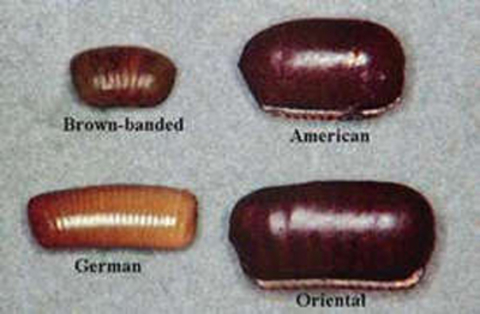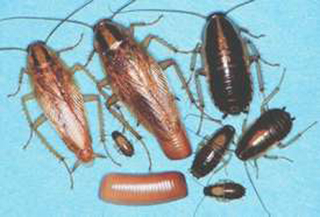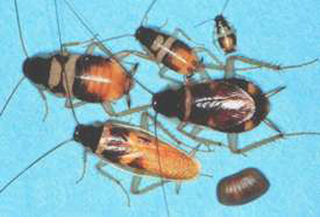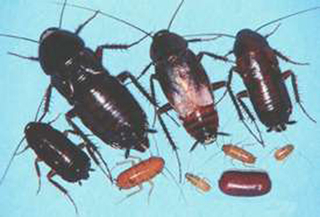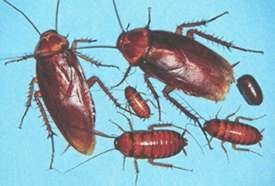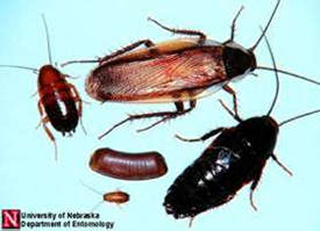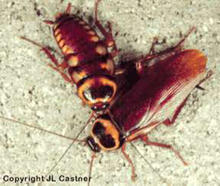Quick facts
- Cockroaches hide during the day and become active at night.
- Cockroaches carry diseases that can cause food poisoning or diarrhea.
- Their saliva, feces and cast skins can irritate allergies and asthma in people, especially children.
- Cleanliness is very important to reduce cockroach infestations.
- It is best to hire a pest management service to treat them.
Cockroaches can be major pests in restaurants, hospitals, warehouses, offices and buildings with food-handling areas. They secrete a substance that can stain surfaces and produce bad odors. They can also destroy fabric and paper products.
How to identify cockroaches
Four kinds of cockroaches can infest homes in Minnesota:
- German cockroach
- Brown-banded cockroach
- American cockroach
- Oriental cockroach
Submit a sample to an insect specialist or a pest management expert if you have trouble identifying the type of cockroach you have.
Only a small percentage of the actual number of cockroaches in a house are seen. Correct identification of cockroaches is important as many insects look similar (e.g. long-horned beetles, crickets, leaf-footed bugs and ground beetles).
- A cockroach has a flattened, oval body and long antennae (about the length of their body).
- When looking at a cockroach from above, its head is hidden from view.
- It has six strong legs covered with spines.
- Many adult cockroaches have fully developed wings, but only few fly.
- Young, immature cockroaches resemble adults but are smaller and do not have wings.
Life cycle of cockroaches
- A cockroach has three stages during its life cycle: egg, nymph and adult.
- Adults lay eggs contained within dark-colored egg cases (size and shape of a dry kidney bean).
- Depending on the species, an egg case contains 16 - 50 eggs.
- Eggs hatch into young cockroaches called nymphs, which are more numerous than adults.
How to keep cockroaches out of your house
Take precautions while moving
- When moving, use boxes and packing material from a place free of cockroaches.
- When packing, watch for cockroaches and their egg capsules.
- Remove and destroy any that you find.
- Take all boxes out of the home at night and store in a place without cockroaches.
- If storing boxes overnight in infested buildings, keep them off the floor and away from walls by placing them on chairs or tables.
- During winter, you can store boxes in unheated locations such as garages.
- In your new home, watch for egg cases and cockroaches that may have survived.
Remove boxes, newspapers and paper bags
Corrugated cardboard boxes are a good source of cockroach infestations. Examine bags, boxes and luggage brought into your home for the presence of cockroaches or their egg capsules.
To confirm you have cockroaches:
- Place sticky traps so that they are tight against edges, where walls meet floors.
- Place traps in areas where cockroaches are likely to occur, such as in cupboards and around refrigerators, stoves, and sinks.
You can reduce the number of cockroaches by getting rid of places they like.
- Remove corrugated cardboard boxes, newspapers, bags and other unnecessary clutter.
- When storing items, leave space between packages.
- Use caulk to seal spaces and cracks where cockroaches hide. Concentrate on areas where cockroach numbers are the highest.
- Seal spaces where plumbing or electrical wiring goes through walls with steel wool or other rough material.
- Put covers (escutcheon plates) on points where plumbing enters the wall, to restrict movement of cockroaches.
Keep your home clean
If you limit access to food and water, cockroaches cannot survive and reproduce.
- Keep all food stored in a refrigerator or in insect-proof containers made of plastic, metal or glass with tight-fitting covers.
- Do not leave pet food and water out overnight.
- Wash your dishes, pans and utensils as soon as you are done using them.
- Remove all food or spilled drinks from countertops, and clean counters, sinks and tables with soapy water.
- Vacuum floors and all cracks and crevices to remove debris and food.
- Take garbage out daily in closed plastic containers. Keep waste containers clean.
- Repair any leaky water pipes or faucets.
- Recycle cans and bottles on a regular basis.
- Wash and clean recycling bins.
- Air out and dry out damp places.
How to protect your home from cockroaches
Vacuuming is very effective in removing cockroaches and egg cases when combined with other methods.
Use vacuums with a high efficiency particulate air (HEPA) filter to reduce cockroach debris that may become airborne.
If you see cockroaches on small items like toasters, clocks or boxes:
- Place them in a plastic bag, close it up, and put the bag in the freezer.
- In winter, you can set the bag outside when temperatures are near 0 degrees F.
- Leave the bag in the cold for 5 days.
- Clean the item before bringing it back into your home.
It is best to hire a pest management service to treat cockroaches with pesticides. They have the experience and tools to successfully eliminate these pests from your home.
- Before applying pesticides yourself, it is important to determine where the cockroaches are most common.
- Distribute traps like Roach Motel or Roach Trap in a variety of locations, especially in areas where cockroaches have been seen.
- Place traps tightly against walls or objects so cockroaches can not go around them.
- Cockroaches prefer warm, moist areas near water sources.
- Record the number of cockroaches trapped and apply insecticides near the traps with the largest catches.
There are several options for pesticide treatment of cockroaches.
Cockroach baits are typically available in ready-to-use plastic, child-proof containers.
- Common active ingredients include:
- abamectin
- fipronil
- hydramethylnon
- Place them in precise locations where you frequently find cockroaches.
- Baits act slowly and the results may not be seen right away.
Dusts like boric acid can be used to supplement baits.
- Common trade names include Roach Powder and Roach Prufe.
- Place boric acid in isolated places, such as behind and under refrigerators, stoves and sinks.
- Do not apply boric acid where children and pets can reach it.
Pesticide sprays are available in ready-to-use aerosol or liquid products.
- Some common active ingredients include:
- permethrin
- deltamethrin
- cyfluthrin
- cypermethrin
- Spray in specific sites in cracks behind sinks, cabinets, around drains and plumbing, and other sites allowed by the label.
- Do not spray on flat surfaces such as countertops, floor surfaces, etc.
- Avoid contaminating food, dishes or utensils.
- Do not use aerosol foggers and bombs.
- These products do not reach the cracks where cockroaches hide.
- They also increase the exposure to people and pets.
- It is difficult to control cockroaches in multi-unit dwellings, such as apartment buildings.
- It is necessary to treat the infested unit and all adjacent units, with the help of a pest management service.
CAUTION: Mention of a pesticide or use of a pesticide label is for educational purposes only. Always follow the pesticide label directions attached to the pesticide container you are using. Be sure that the area you wish to treat is listed on the label of the pesticide you intend to use. Remember, the label is the law.
Types of cockroaches
This is the most common indoor cockroach species in Minnesota. It favors warm (70° to 75° F), humid atmospheres.
- It is found near plumbing fixtures (in kitchens/bathrooms), in cracks in cupboards, and under drawers and kitchen sinks.
- These cockroaches often cluster together in favorable hiding areas. When severe infestations occur, they may be found in other sections of buildings.
- The adult is about ½ inch long, light brown or tan and has two dark longitudinal bands behind the head.
- The nymph is smaller and dark-colored with a light-colored streak running down its back.
- An immature nymph reaches maturity in about 40 to 125 days.
- This species has the highest reproductive potential of all the common pest cockroaches. Females produce about 30 to 50 eggs at a time.
- The female carries the egg case until the eggs are ready to hatch.
- Adult females live about 200 days, producing six to eight egg cases throughout their life.
This cockroach is common in Minnesota homes. This species prefers high areas, hiding behind pictures and clocks, beneath furniture and among books.
- They prefer warmer temperatures (greater than 80° F) than the German cockroach and are found on appliances such as radios, televisions and refrigerators.
- The two species are rarely found together.
- Adults are about ½ inch long.
The male adult has a golden brown narrow body with wings extending beyond the tip of its abdomen. A female adult has a dark chestnut brown teardrop-shaped body, and wings that do not completely cover the abdomen.
- Both sexes have distinctive horizontal yellow bands.
- The female often glues its egg case on furniture or in appliances.
- Eggs take about 70 days to hatch and about 160 days for the young to reach maturity.
- A nymph is recognized from the two pale bands which run horizontally across its body.
Often called a water bug, it prefers dark, damp places like basements, cellars, crawl spaces and sewers. It may also be found near drains, leaky water pipes and under refrigerators, sinks, washing machines and floors.
- It prefers temperatures under 84° F.
- The Oriental cockroach can tolerate cool environments and has been found outdoors in freezing weather.
- It is found outdoors under sewer covers feeding on all types of garbage and organic material.
- This species may enter buildings in case of a change in the seasons, excess rainfall or lawn mowing.
- It is mostly found on the first floors of buildings.
- It produces a strong smell and is considered one of the dirtiest cockroach.
- An adult is about 1 to 1-1/4 inches long and dark brown, almost black.
- A male has fully developed wings which are shorter than the body.
- A female has very short, rudimentary wings.
- A nymph is similar in appearance to a female but is smaller and wingless.
- A female deposits about eight egg cases (16 eggs in each case) during its lifetime.
- The eggs hatch and develop into adults within 300 to 800 days.
This is the largest cockroach species to infest buildings in Minnesota. It is occasionally found in homes, but is more common in restaurants, grocery stores, bakeries and other sites where food is prepared.
- It favors very warm, moist places (temperatures in excess of 82° F).
- The American cockroach likes fermenting foods, e.g. bread soaked with beer.
- It is mostly found in basements and ground floors.
- Sewers and drain lines may help this pest invade new areas.
- Both the adult male and female are about 1-1/2 to 2 inches long, reddish brown and possess long wings that cover their abdomen.
- A female typically produces 9 to 10 egg cases which are deposited in a crack or crevice.
- Eggs hatch in about 45 days with each case producing about 14 young.
- An immature nymph is reddish brown and wingless.
- A young nymph matures between 215 days and 400 days.
- The average life span for adult females is about 440 days.
This species lives in wooded areas in rotting logs and under loose bark. It can accidentally invade homes, cabins, cottages, in or near wooded areas.
- This cockroach is not a common household pest and it does not reproduce indoors.
- A Pennsylvania wood cockroach can be brought indoors on firewood.
- The males are strong fliers and may enter open doors and windows from trees and logs.
- The adult male is one inch long, dark brown, with light-colored bands on the edge of the body near the head.
- Males also have long, well-developed wings.
- The adult female is similar, but with very short wings, measuring about 1/2 inch long.
- Adult females and immature nymphs can be confused with the Oriental cockroach. But the Oriental cockroach lacks the light bands on the edge of its body near the head.
Control of Pennsylvania wood cockroach
- Reduce their breeding places by removing decayed and fallen logs close to the building.
- Physically remove an occasional Pennsylvania wood cockroach found indoors.
- If larger numbers are entering the home, treat the exterior of the building, particularly around doors and windows, with a residual insecticide, like:
- permethrin
- bifenthrin
- cyfluthrin
- These are subtropical cockroaches rarely seen in Minnesota and cannot survive in the cold, dry conditions.
- They are found, only if they have been accidentally transported into the state.
- These cockroaches can survive if they enter a warm and humid location (e.g. greenhouse).
- Australian cockroaches are found in similar areas as the American cockroach.
- The Surinam and Madeira cockroaches can sometimes be found in potted plants associated with contracted indoor landscaping and indoor arboretums.
Reviewed in 2024


